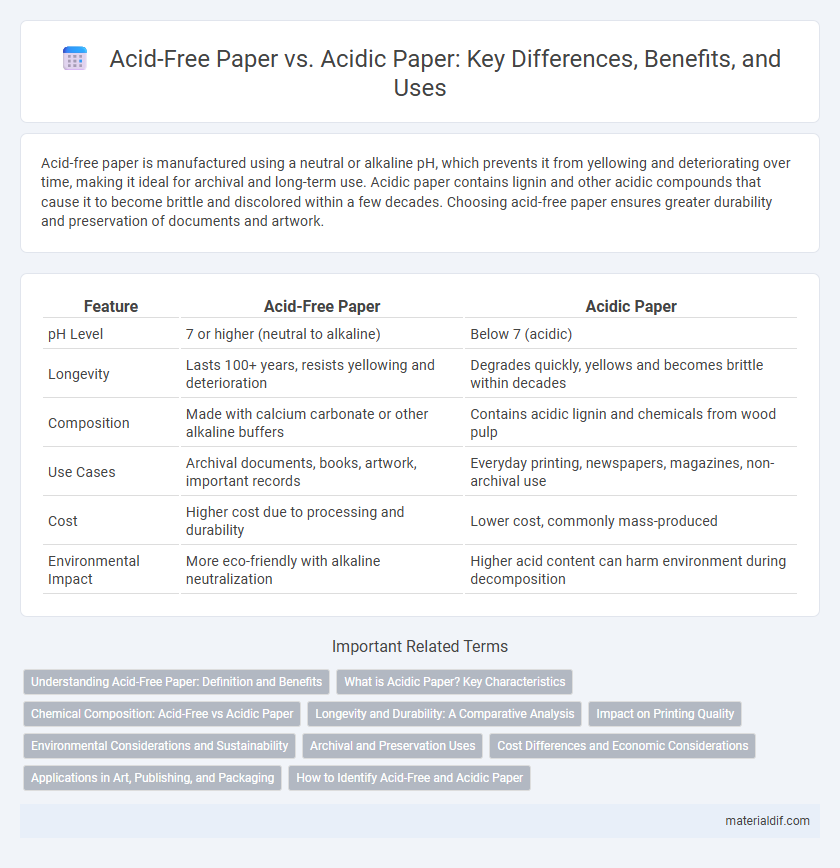Acid-free paper is manufactured using a neutral or alkaline pH, which prevents it from yellowing and deteriorating over time, making it ideal for archival and long-term use. Acidic paper contains lignin and other acidic compounds that cause it to become brittle and discolored within a few decades. Choosing acid-free paper ensures greater durability and preservation of documents and artwork.
Table of Comparison
| Feature | Acid-Free Paper | Acidic Paper |
|---|---|---|
| pH Level | 7 or higher (neutral to alkaline) | Below 7 (acidic) |
| Longevity | Lasts 100+ years, resists yellowing and deterioration | Degrades quickly, yellows and becomes brittle within decades |
| Composition | Made with calcium carbonate or other alkaline buffers | Contains acidic lignin and chemicals from wood pulp |
| Use Cases | Archival documents, books, artwork, important records | Everyday printing, newspapers, magazines, non-archival use |
| Cost | Higher cost due to processing and durability | Lower cost, commonly mass-produced |
| Environmental Impact | More eco-friendly with alkaline neutralization | Higher acid content can harm environment during decomposition |
Understanding Acid-Free Paper: Definition and Benefits
Acid-free paper is manufactured using a neutral or alkaline pH process, preventing the natural deterioration caused by acidic elements found in traditional acidic paper. This paper type resists yellowing, brittleness, and degradation over time, making it ideal for archival purposes, artwork, and important documents. Understanding the composition and longevity benefits of acid-free paper ensures informed choices for preserving valuable materials.
What is Acidic Paper? Key Characteristics
Acidic paper contains lignin and has a pH below 7, causing it to yellow, become brittle, and degrade over time. Key characteristics include rapid aging, reduced durability, and susceptibility to discoloration under exposure to light and air. This type of paper is commonly used in cheaper printing and packaging materials, making it unsuitable for long-term preservation.
Chemical Composition: Acid-Free vs Acidic Paper
Acid-free paper is manufactured using neutral or alkaline pH processes, often incorporating calcium carbonate as a buffering agent to prevent acid degradation over time. In contrast, acidic paper contains lignin and sulfuric acid residues from wood pulp processing, leading to its characteristic low pH and increased susceptibility to yellowing and brittleness. The chemical stability of acid-free paper makes it ideal for archival purposes, preserving documents and artwork without the rapid breakdown associated with acidic paper.
Longevity and Durability: A Comparative Analysis
Acid-free paper exhibits superior longevity and durability compared to acidic paper due to its neutral pH, which prevents the chemical breakdown of cellulose fibers over time. Acidic paper tends to yellow, become brittle, and deteriorate faster because of acid hydrolysis, significantly reducing its archival quality. Preservation experts recommend acid-free paper for important documents and artworks to ensure long-term stability and resistance to aging.
Impact on Printing Quality
Acid-free paper ensures superior printing quality by resisting yellowing and degradation over time, preserving sharpness and color fidelity in prints. Acidic paper, prone to acid hydrolysis, often leads to faded images, brittleness, and compromised print longevity. High-quality archival prints and professional documents benefit significantly from acid-free paper's stability and durability.
Environmental Considerations and Sustainability
Acid-free paper significantly reduces environmental impact by preventing the release of harmful acids during decomposition, ensuring longer degradation periods that minimize landfill toxins. Its production typically involves sustainable forestry practices and chlorine-free bleaching, promoting eco-friendly resource use and reduced water pollution. In contrast, acidic paper contributes to faster deterioration and chemical leaching, increasing environmental hazards and reducing recyclability, which undermines long-term sustainability efforts.
Archival and Preservation Uses
Acid-free paper is essential for archival and preservation uses due to its neutral pH level, which prevents yellowing and deterioration over time, ensuring long-term stability of documents and artwork. Acidic paper contains lignin and has a low pH, causing rapid degradation and brittleness, making it unsuitable for preservation purposes. Museums, libraries, and archives prefer acid-free paper for maintaining the integrity of historical records and valuable collections.
Cost Differences and Economic Considerations
Acid-free paper generally costs more than acidic paper due to the higher quality materials and manufacturing processes involved, which enhance longevity and resistance to yellowing. While the initial investment is higher, acid-free paper reduces long-term expenses related to document preservation, restoration, and potential loss from degradation. For archival, legal, or artistic purposes, the economic benefits of acid-free paper outweigh the upfront costs, promoting durability and value retention over time.
Applications in Art, Publishing, and Packaging
Acid-free paper, known for its longevity and resistance to yellowing, is preferred in fine art prints, archival publishing, and high-quality packaging to preserve originality and prevent deterioration. Acidic paper, often used for everyday printing and economical packaging, tends to degrade faster due to its low pH, leading to brittleness and discoloration over time. In applications prioritizing durability and aesthetic preservation, acid-free paper significantly enhances longevity and visual integrity compared to acidic alternatives.
How to Identify Acid-Free and Acidic Paper
To identify acid-free paper, check for labels indicating pH neutrality or archival quality, often marked as pH 7 or higher. Acidic paper typically feels yellowed or brittle due to lignin content and may lack archival certification. Conducting a simple decolorization test with baking soda solution or observing paper's longevity and texture under magnification can further distinguish acid-free from acidic paper.
Acid-Free Paper vs Acidic Paper Infographic

 materialdif.com
materialdif.com